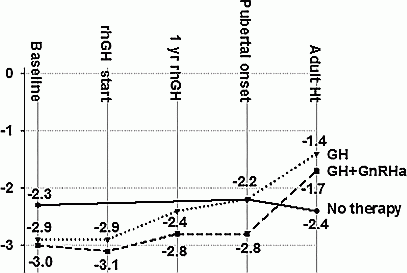ESPE2016 Poster Presentations Growth P2 (47 abstracts)
Delaying Puberty with GnRHa does not Promote Adult Height in GH Treated Children Who Enters Puberty at Average Age
Felicia Hansson & Peter Bang
Department of Clinical and Experimental Medicine, Linköping University, SE-58185 Linköping, Sweden
Background: Delaying puberty with GnRHa in an attempt to improve final height in GH treated children is relatively common in clinical practice. Such treatment is only supported by one retrospective study in which pubertal start was relatively early.
Objective and hypotheses: To retrospectively assess adult height in children with short stature treated with GH and receiving or not receiving GnRHa. We hypothesized that delaying puberty with GnRHa improves adult height.
Method: We identified 70 children (35 girls) assessed for short stature in our clinic between 2000 and 2009 and in whom we had data on adult height. rhGH monotherapy was given to 27 patients (GH start at mean (S.D.) age 10.1 (2.2) years), rhGH plus GnRHa therapy to 24 patients (GH start at age 10.9 (2.2) years and GnRH start at age 11.9 (2.9) years) and the remaining 19 patients did not receive any treatment (Investigated at age 11.2 (3.7). Patients had diagnosis of IGHD, SGA and ISS.
Results: Adult mean (S.D.) heights were −1.4 (0.9) SDS in rhGH and −1.7 (0.6) SDS in rhGH plus GnRHa treated patients, significantly higher than −2.4 (0.8) in controls (P<0.01 and P<0.05, respectively). The gain from baseline to adult height did not differ between patients treated with rhGH or rhGH plus GnRHa but was larger than in non-treated children (P<0.005 and P=0.011, respectively). The distance from reference mean age at B2 or testicular volume >3 ml to pubertal start was 0.7, 0.3 and −0.3 years, respectively. The most important predictors of adult height were a low baseline height, long distance to MPH and a low GHmax.
Conclusion: This study does not support that delaying puberty with GnRHa promote adult height in GH treated children who enters puberty at average age.

 }
}



